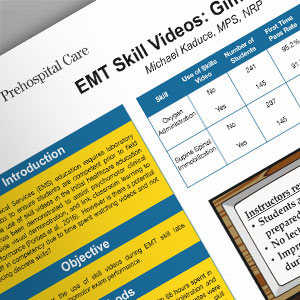ABSTRACTS
Does Watching Skill Videos Affect EMT Psychomotor Pass Rates?Author: Michael Kaduce MPS, NRP | EMT Program Director | UCLA Center for Prehospital Care Associate Authors:
Introduction EMS education requires laboratory time to ensure students are competent before field rotations. The use of skill videos in the initial healthcare education classroom has been demonstrated to assist clinical skill development, provide visual demonstration, and link classroom learning to skills performance. However, is there a trade off in competency due to time watching videos and not practicing skills? Hypothesis Time spent watching demonstrational videos in EMT skill labs does not reduce first-time pass rate on the NREMT psychomotor exam. Methods The UCLA hybrid EMT program is 182 hours with 68 hours spent in laboratory. A retrospective review of oxygen administration and supine spinal immobilization first-time psychomotor pass rates were evaluated. Three cohorts of students who did not use the skill videos were compared with 2 cohorts who watched the skill videos before the start of each of the respective laboratory rotations. The demonstrational videos are between 3 and 8 minutes long and are provided online. A t-Test (two-sample assuming unequal variances with statistical threshold of 0.05) was performed comparing first-time pass rates of the respective skill with and without videos. This study received IRB approval from the UCLA David Geffen School of Medicine. Results In this study, 241 and 237 student’s first-time psychomotor pass rates were evaluated without the oxygen administration or supine spinal immobilization skill videos respectably. An additional 145 student’s first-time psychomotor pass rates were evaluated with the skill videos for the 2 skills. The first-time pass rate for oxygen administration without and with the skill video was 95.2% and 91.8%, respectively. The first-time pass rate for supine spinal immobilization without and with the skill video is 82.7% and 82.1% respectively. The p value for oxygen administration is 0.24 and supine spinal immobilization is 0.42. Conclusion In these data, there were no significant difference in first-time pass rates on the psychomotor exam with or without the skill videos. Showing a short, specific skill video which highlights important ideas, can increase learning acquisition and limit time spent lecturing in the laboratory.
|

